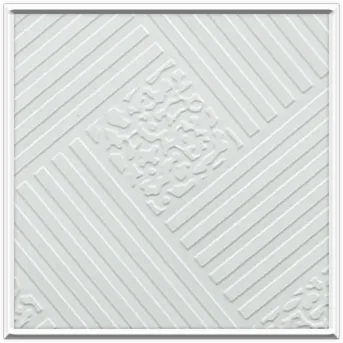Dec . 29, 2024 07:54 Back to list
Creating a Tile Grid Ceiling for Stylish Interior Design Solutions
Understanding Tile Grid Ceiling A Comprehensive Overview
Tile grid ceilings, often referred to as drop ceilings or suspended ceilings, have become a popular choice in various architectural and interior designs. They provide an aesthetically pleasing finish while also offering practical benefits. This article delves into the intricacies of tile grid ceilings, exploring their structure, applications, benefits, and installation process.
What is a Tile Grid Ceiling?
A tile grid ceiling is a suspended ceiling system that consists of a grid framework, usually made of metal, which supports a series of lightweight tiles. These tiles can be constructed from various materials including mineral fiber, metal, PVC, or gypsum. The grid is typically installed a few inches below the original ceiling, creating a void space above it. This space is invaluable for housing electrical wiring, plumbing, and HVAC ductwork, facilitating easy access for maintenance and upgrades.
Structure of a Tile Grid Ceiling
The structure of a tile grid ceiling involves several components. The primary elements include
1. Main Tees These are the primary support beams that run across the ceiling, usually spaced at 4 feet apart. 2. Cross Tees These are the perpendicular beams that connect to the main tees, forming a grid pattern. They help in supporting the tiles and can vary in length depending on the tile size.
3. Perimeter Trim This is the material that finishes the edges of the ceiling grid, providing a clean and professional look.
4. Tiles The decorative panels that fill the grid. They come in various styles, textures, and finishes, allowing customization based on aesthetic preferences.
Applications of Tile Grid Ceilings
Tile grid ceilings are versatile and can be used in numerous settings, including
- Commercial Spaces Office buildings, retail stores, and schools commonly utilize tile grid ceilings. They help absorb sound, reduce noise levels, and improve acoustics. - Residential Areas Homeowners might choose to install tile grid ceilings in basements, kitchens, or bathrooms to conceal utilities while enhancing the room's design.
- Healthcare Facilities Hospitals and clinics often employ these ceilings because of their ease of cleanability and ability to support integrated lighting and HVAC systems.
Benefits of Tile Grid Ceilings
The advantages of tile grid ceilings extend beyond their aesthetic appeal
tile grid ceiling

1. Easy Installation Installing a tile grid ceiling is comparatively straightforward, often requiring less time and labor than traditional plaster or drywall ceilings.
2. Accessibility The space above the tiles provides easy access for repairs and modifications without the need for extensive renovations.
3. Acoustic Control Tile grid ceilings can significantly reduce noise, making them ideal for settings that require quiet environments.
4. Fire Resistance Many acoustic tiles are fire-rated, enhancing safety in commercial buildings.
5. Energy Efficiency By serving as a barrier for hot and cold air, these ceilings can contribute to lower energy costs through improved insulation.
Installation Process
The installation of a tile grid ceiling involves several steps
1. Planning Determine the desired height and layout of the grid. It's essential to consider any existing fixtures or utilities that might interfere with the ceiling.
2. Marking Use a chalk line to mark where the main tees will be installed, ensuring a level installation.
3. Hanging the Grid Secure the main tees to the structure above, followed by adding cross tees to create the grid layout.
4. Fitting the Tiles Insert the ceiling tiles into the grid, ensuring they fit snugly and securely.
5. Finishing Touches Install perimeter trim to cover any gaps at the edges of the ceiling for a professional appearance.
Conclusion
Tile grid ceilings represent a harmonious blend of form and function. Their flexibility, ease of installation, and practical advantages make them a preferred choice in various environments. Whether you're a homeowner seeking to renovate a space or a business looking to enhance the acoustic and aesthetic qualities of your facility, tile grid ceilings offer a solution that caters to diverse needs. With an array of design options, they can transform any space into a functional and visually appealing area.
-
Quality Ceiling Trap Doors & Access Panels | Easy & Secure AccessNewsAug.30,2025
-
Durable Ceiling T Grid Systems | Easy InstallationNewsAug.29,2025
-
PVC Gypsum Ceiling: Durable, Laminated Tiles for Modern SpacesNewsAug.28,2025
-
Pvc Gypsum Ceiling Is DurableNewsAug.21,2025
-
Mineral Fiber Board Is DurableNewsAug.21,2025
-
Ceiling Tile Clip Reusable DesignNewsAug.21,2025







